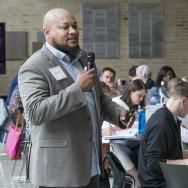In 2014, the University of Chicago’s Urban Education Institute and Network for College Success launched an innovative initiative to provide educators, policymakers and families with research, data and resources on the milestones that matter most for college success.
Part of a transformative mission to improve the quality of urban education, the To&Through Project aims to significantly increase the percentage of students who make it to and through high school and college. To further the project’s impact, the Urban Education Institute and Network for College Success recently invited local and national education leaders to discuss innovative research from UChicago, as well as stories of progress from educators and nonprofits on the front lines of the city and nationwide effort to improve students’ educational attainment.
In the event’s keynote address, former U.S. Secretary of Education John King described his own experience in New York City public schools, highlighting how complicated navigating the path to and through high school and college can be for many students. That sentiment was echoed throughout the day, in remarks from Chicago Mayor Rahm Emanuel and Chicago Public Schools CEO Janice Jackson, who noted the University of Chicago’s impact in studying and supporting improvement in student outcomes.
“If you look at the work and the strategy for improving Chicago Public Schools, you see the research that has come out of the University of Chicago,” Jackson said. “I’ve talked with other superintendents; I can’t tell you how many of them are surprised of the data-sharing agreement and the trust that has been built between these two institutions.”
“If you look at the work and the strategy for improving Chicago Public Schools, you see the research that has come out of the University of Chicago.”
The event also highlighted research from the To&Through Project. Three new reports focused on these key areas:
Educational attainment: The number of CPS ninth-graders projected to earn a bachelor’s degree within six years of high school graduation has more than doubled over the last decade, from 9 percent in 2006 to 19 percent in 2017. The research also highlights increases in high school graduation and college enrollment rates.
Lessons from Chicago’s approach to research, data and practice in education: The report highlights Chicago’s approach to creating large-scale, equitable improvements in students’ outcomes and the central role data has played in driving Chicago’s educational gains over the past decade.
The transition to high school: Failure in a non-core course (such as art or physical education) in ninth grade is equally as detrimental as failure in a core course (English, math, science, social studies) to students’ likelihood of graduating from high school. The study also shows that all CPS students are at risk of significant declines in GPAs in core courses during the transition to high school.
Although CPS has made noteworthy progress, students continue to face complicated obstacles on the road through high school and college, King noted. “Chicago is doing so well on the to part…And so we celebrate that students are getting to college, and now the question is: How do we make sure that when they get there, they finish and they productively enter the economy?”
The UChicago Consortium on School Research is planning to address that question in a forthcoming study focused on how well colleges are supporting students on the path from college to the workforce.









